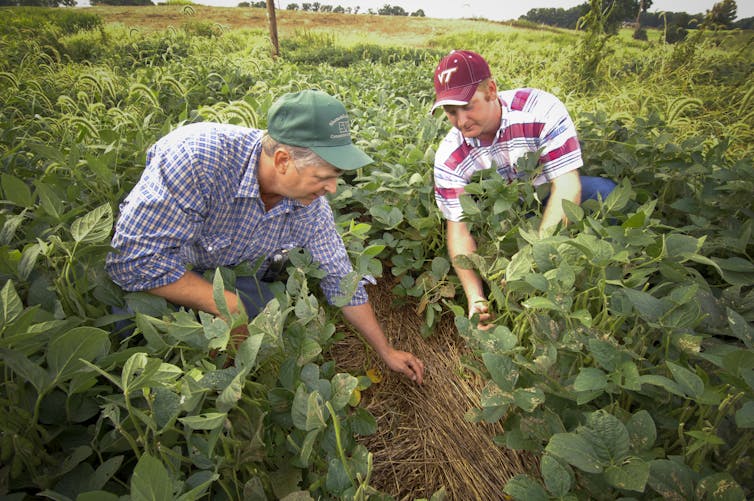This article was originally published on¬Ý, which features includes relevant and informed articles, written by researchers and academics in their areas of expertise and edited by experienced journalists.
is a professor in the Department of Plant, Food and Environmental Sciences in π˚Ω¥ ”∆µ's Faculty of Agriculture.
Under the 2015 Paris Agreement, nations pledged to keep the average global temperature rise to below 2C above pre-industrial levels and to take efforts to narrow that increase to 1.5C. To meet those goals we must not only stop the increase in our greenhouse gas emissions, we must also draw large amounts of carbon dioxide (CO2) from the atmosphere.
The simplest, most cost effective and environmentally beneficial way to do this is right under our feet. We can by storing it in our agricultural soils.
Soils are traditionally rich in carbon. They can contain as much as five per cent carbon by weight, in the form of soil organic matter — plant and animal matter in various stages of decomposition.
But with the introduction of modern agricultural techniques, including the plow, soil organic matter content has dropped by half in , including . That carbon, once stored in the ground, is now found in the atmosphere and oceans as CO2 and is contributing to global warming.
The organic compounds found in soil are the glue that hold soil particles together and help give the soil structure. Like the walls of a building, this structure creates openings and passageways that allow the soil to conduct and store water, contain air, resist soil erosion and provide a habitat for soil organisms.
Plowing breaks apart soil aggregates and allows microorganisms to eat the soil organic compounds. In the short-term, the increased microbial activity releases nutrients, boosting crop productivity. In the long-term the loss of structure reduces the soil’s ability to hold water and resist erosion. Ultimately, crop productivity drops.
How can we make soil organic matter?
First and foremost, we need to disturb soil less. The advent of no-till and reduced tillage methods have allowed us to increase the carbon content of soils.
No-till and direct-seeding methods place the seed directly into the soil, minimizing the disturbance associated with seedbed preparation. The lack of disturbance allows the roots and crop residues from the previous crops to form soil organic matter. It reduces the degradation of the soil organic matter already present in the soil.

In Canada, we are already benefiting from reduced tillage. In the Prairies, no-tillage agriculture has increased from less than five per cent of the land area in the early 1990s .
The situation is a bit more complex in Eastern Canada. The region‚Äôs soil type and climate make it less easy to build soil organic matter. At π˚Ω¥ ”∆µ‚Äôs Atlantic Soil Health Lab, we are exploring the potential of various cropping practices to increase soil organic matter content in the soils of Atlantic Canada. While the potential to store carbon may not be as great as in Western Canada, the benefits of increased soil organic matter content are far greater because of the critically low levels of organic matter.
Secondly, we can use more diverse crop rotations. Forage crops — such as grasses, clovers and alfalfa — penetrate the soil with extensive root systems that lead to the formation of soil organic matter. Short rotations dominated by crops that have poor root systems (corn, soybeans) are not effective in building soil organic matter.
Farmers can also build soil organic matter by adding organic amendments such as animal manure, composts, forestry residues (wood chips) or biosolids to the soil.
Using the right amount of fertilizer is also important. Fertilizers can improve plant growth, lead to larger roots and add more plant matter to the soil in the unharvested portion of the crop. However, too much nitrogen fertilizer can result in the production of the powerful greenhouse gas nitrous oxide and offset the benefit of increased soil organic matter formation.
Farmers need economic incentives
, a non-profit organization that researches solutions to global warming, has estimated that global (building soil organic matter) could remove 14 gigatones (billion tonnes) of CO2.
This would reduce the CO2 in the atmosphere below the current — a level unpassed for several million years — while developing more fertile, resilient soils to feed people for years to come and keep forests intact.
These approaches seem like obvious solutions. Why are they not more widely adopted? The short answer is economics.
The benefits of drawing down CO2 and building soil organic matter play out over decades. But the costs associated with these practices often do not have increased returns in the short-term.
![]() Farmers often make decisions in response to short-term economic pressures and government policies. Improved soil management is a public good. We need economic tools and short-term incentives that encourage producers to adopt these practices for the good of all.
Farmers often make decisions in response to short-term economic pressures and government policies. Improved soil management is a public good. We need economic tools and short-term incentives that encourage producers to adopt these practices for the good of all.
Read the on The Conversation.
π˚Ω¥ ”∆µ University is a founding partner of The Conversation Canada, a new-to-Canada online media outlet providing independent, high-quality explanatory journalism. Originally established in Australia in 2011, it has had more than 85 commissioning editors and 30,000-plus academics register as contributors. A full list of articles written by π˚Ω¥ ”∆µ academics can be found on¬Ý.

